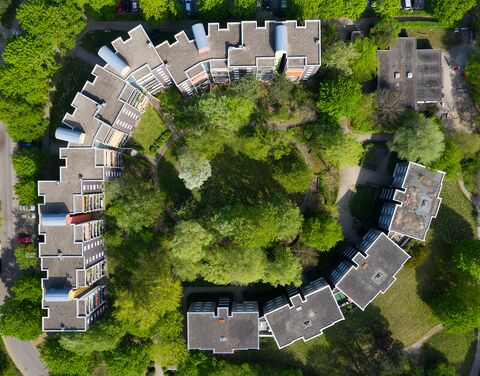
The circular economy is becoming increasingly important in the construction and real estate sectors. Valeria Bianco, Sustainability Manager at AXA Investment Managers, explains what's needed for a circular real estate economy.
What exactly does a circular real estate economy mean?
Real estate and construction are among the most resource-intensive of all sectors. A lot of CO2 is emitted and a great deal of resources are consumed not just to run buildings, but to construct them as well. In this context, a circular economy means that construction materials last longer, are easier to repair or can be recycled. Materials we remove during a renovation, for example, may no longer be state of the art, but they're often still usable. Reusing them can help us to save resources.
Are there other ways to reduce CO2 emissions and resource consumption?
Besides reusing old parts, we can also repurpose buildings, for example by turning abandoned office blocks into homes. With so many people spending more time working from home these days, a large amount of office space is going unused. In some cases, the floor plan lends itself extremely well to being repurposed.
So we should renovate more buildings rather than putting up new ones?
Absolutely. We try to weigh up before every construction project whether a new building is really needed or whether we can renovate an existing one instead – perhaps even reusing some of its components. At AXA Investment Managers, we've been studying the circular economy carefully since 2021, and we're currently in the process of drawing up our own guidelines that will help us to be as resource-efficient as possible in every single project.
"We try to weigh up before every construction project whether a new building is really needed or whether we can renovate an existing one instead – perhaps even reusing some of its components."
What do these guidelines include?
Our strategy is based on the two overarching goals of reducing CO2 emissions and minimizing our use of resources. We've defined ten concrete measures to achieve these. I'd like to tell you about the ones I think are most important. For starters, we check before each construction project whether we really need a new building or whether we can simply renovate what's already there. We also want to catalogue the materials before we begin demolition to make it easier to reuse them later on. On top of this, we aim to plan layouts that can easily be repurposed at a later date. Reducing the materials used or choosing materials that last longer can also play a key role in saving resources. If, for example, we build a room without a paneled ceiling, we can save on materials while also making the ceiling more accessible for repairs.
That all sounds great, but how easy is it to put into practice?
Of course we can't implement all ten measures in every case, but the guidelines serve as an aid to gauging what's possible in each individual project. When it comes to renovations in particular, the existing structure limits our options. That said, even if we can only implement two of the ten measures, it still brings us a step closer to our overarching goals of reducing CO2 emissions and minimizing our use of resources.
Implementing all the measures wouldn't be profitable in some cases, would it?
It goes without saying that we always have to bear the cost/benefit ratio in mind, but our guidelines now include a third parameter: the life cycle assessment. Instead of just considering the cost and the standard of fit-out, we also look at how much CO2 is emitted by each construction project. This allows us to make an environmental assessment and compare it against other projects.
Are there projects in the AXA Investment Managers portfolio that have already implemented the measures?
An excellent example of office space being converted into living space is the Lise & Lotte development in Köniz. The existing structure was very good, which made it possible to save a lot of "gray" energy. We took a very careful approach here to ensure that we could reuse some of the materials and thus minimize the resources needed for the project. The toilets, for instance, were still in perfect condition, so we reinstalled them in the communal areas. Existing glass partitions, meanwhile, were reused in the laundry rooms and corridors. We did replace the glazing in the windows, but we left the frames as they were wherever possible. We're planning further pilot projects in addition to the one in Köniz that will aim to implement as many of the measures I've mentioned as they can.

Valeria Bianco works for AXA Investment Managers Switzerland where she is responsible for sustainability issues in the real estate sector. She studied environmental sciences at the ETH, majoring in biogeochemistry and pollutant dynamics. As an advisor to the Climate Foundation Switzerland, she also applies her expert knowledge for AXA in assessing funding applications, and helps to reduce the carbon emissions of Swiss SMEs.
AXA IM is one of the first partners to sign up to the Circular Building Charter, which is focused on building a network to pursue the shared ambition of a circular real estate economy.